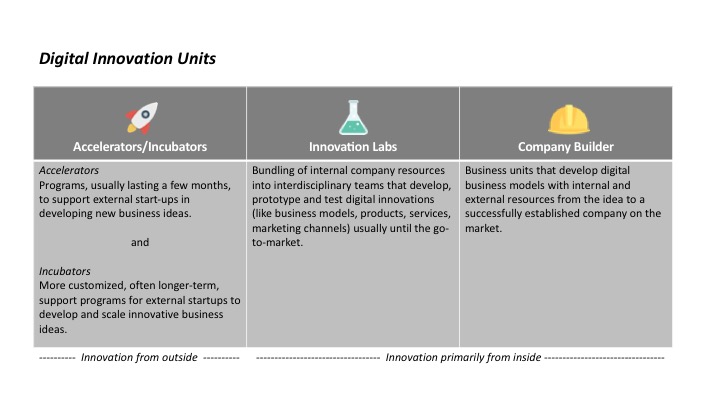Large corporations have been struggling with breakthrough innovations for a long time. As pointed out by Clayton Christensen in ‘The Innovator’s Dilemma’ (1997), incumbent firms that capture a significant share of a given market tend to focus on retaining their current, highly profitable customer base while ignoring the lower end of the demand side. Once this behavior becomes institutionalized, corporations focus on efficiency gains and incremental innovations of their product or service portfolios. Sponsored by senior management, corporates should hence establish separate divisions that focus on reviving entrepreneurial spirit and exploring digital opportunities at the low end of the market. But where to start?
In order to foster entrepreneurial thinking and the development of digitally enriched business ideas, corporations have set up different forms of digital innovation units (DIUs) that are supposed to mimic startups behavior. Their common goal is the strategic advancement of corporations as well as delivering tangible contributions to the digital transformation through the repeated development of incremental to disruptive innovations.
2/3 of all companies listed in the German DAX index have established at least one digital innovation unit – some claim to have set up more than 40 at locations all over the world.
These units are normally established outside existing structures, are equipped with toys like Legos and ping pong tables, and work with agile and flexible methods like design thinking, scrum, lean startup or sprints. Furthermore, they often enjoy high degrees of freedom in their operations, include various stakeholders from their networks in the ideation and prototyping process, and are sponsored by senior management.
Three types of DIUs have emerged over the past decade, namely Innovation Labs, Accelerators/Incubators and Company Builder. They have a common objective but differ significantly in their approach and scope. The graphic below offers a first overview of these three approaches and their general objectives.
I will further elaborate on the specific set-up of Innovation Labs in my second post.

